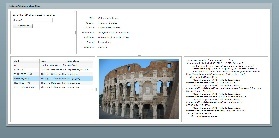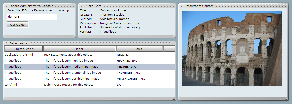|
Under Construction This page is still in the process of being created. IntroductionThere are many opportunities surrounding Fedora to create user interface experiences. Many times it is preferred that these interfaces be deployed in such a was as to be accessed via a web browser. One specific example of this is seen in the plan to replace the Fedora Administrative GUI with a web-based solution. This comparison considers the capabilities and benefits of several tools for building rich internet applications. The goal of this comparison is to aid developers in determining the appropriate tool(s) to use when building UIs for Fedora. DisclaimerThese write ups are generally completed after conducting research about the tool and experimenting with using it for a day or two. If you have implementation experience with a particular tool feel free to add notes or comments. Adobe FlexWhat is it?Flex is a framework for building rich internet applications which are run using Adobe's Flash player in the browser, and Adobe's AIR on the desktop How long did it take to create a test application and get things working? How much code was required?Created a test application which allows a user to view an object's Dublin Core metadata, FOXML, and datastream list after entering an object's PID. The user can then click on any of the datastreams that are image files and view the image. This application required about a day to create (including technology ramp time) and the completed code (an XML file) is 77 lines, including comments and whitespace.
How rich does the API/toolkit appear to be, are there obvious limitations?Rich selection of UI components and widgets. Component placement is organized using layout containers, which provide guidelines and reasonable default values that can be changed to produce a desired look. REST requests can be made very easily in a single line. SOAP requests are also fairly simple to accomplish. The BlazeDS data service can be set up to allow calls directly to POJOs on the server, with transfers in serialized binary. The Flex Builder tool integrates with Eclipse and makes development and deployment convenient. How much documentation/support is available?Documentation seems very good. Answers to development questions are available through examples and API reference information. Complete reference API similar to javadoc is available. Significant documentation is available from Adobe, and there are several recently published books available on Amazon for developing with Flex. What language is used for development? How difficult is it to learn and use?A flavor of XML called MXML is used to lay out and define components while ActionScript is used to handle events and perform more complex behaviors. Didn't have to use ActionScript at all to create the test application, but it appears similar syntax-wise to JavaScript. Learning the tags, attributes, and possible values for MXML takes time but is straight-forward in most cases. What is the deployment scheme?Compiles down to an swf (Flash) file which can be deployed by simply serving the file on a web server. Flex apps can also be deployed on the Adobe AIR platform, allowing them to run on the desktop. Which portions are open source?The language, the SDK, and the (MXML and ActionScript) compilers are open source. LifeCycle Data Services product BlazeDS, along with the AMF (Action Message Format - used to transfer data in compressed binary) spec, are also open source. The Flex Builder application (an Eclipse plugin) is not open source or free, however free licenses are available to staff of educational institutions. Flex applications can be developed and deployed without the Flex Builder. What are the client requirements?Adobe Flash Player 9, the most current Flash player, is required. What is the market penetration?Flex has a wide industry adoption, the flex showcase alone lists around 500 sites built using Flex. The open sourcing of most parts of Flex seems to have encouraged use. What are your impressions of the technology in general?I was impressed by how quickly and easily my test application came together. I appreciated being able to run the end product (a .swf file) directly in a browser (with the latest Flash plugin) without even needing to deploy it to a server. I came away with the impression that, once you get used to MXML and ActionScript you could do a lot in a short amount of time. It's nice that, in general, the application looks pretty decent even if you're not a graphic artist. There tends to be at lot of focus on getting, displaying, and working with data from a server, particularly XML data, which is very useful. A primary drawback is the requirement for the client to have the latest Flash player. Open LaszloWhat is it?Open Laszlo is a framework for building rich internet applications which can be deployed either to Adobe's Flash player or as DHTML in the browser. How long did it take to create a test application and get things working? How much code was required?Created a test application which allows a user to view an object's Dublin Core metadata and datastream list after entering an object's PID. The user can then click on any of the datastreams that are image files and view the image. This application required about two days to create (including technology ramp time) and the completed code (an XML file) is 124 lines, including comments and whitespace.
How rich does the API/toolkit appear to be, are there obvious limitations?All the basic page widgets appear to be available, including trees tabs, sliders, etc. Layouts within a window are organized using views, which are similar to <div> tags in html. This allows specific placement of components, but also requires attention to layout and design in order to produce even a decent looking interface. The API is focused primarily on REST-style retrieval of XML, though SOAP and Java RPC are also supported. Scripting uses Javascript, which is included in tags within the XML. How much documentation/support is available?Documentation seems good. A listing of components with attributes and methods similar to javadoc is available which also includes editable examples. I did find that some components did not operate as presented in the examples (specifically gridcolumn and gridtext) and that some component attribute value options were not clear (specifially the layout attribute of the grid component.) Beyond the component reference there are several other manuals provided by Laszlo Systems. There is one recently published book on Amazon - Laszlo in Action. What language is used for development? How difficult is it to learn and use?What is the deployment scheme?Which portions are open source?What are the client requirements?What is the market penetration?What are your impressions of the technology in general?Google Web Toolkit (GWT)AJAX libaries (Dojo, Rico, etc) with HTML, CSS |

